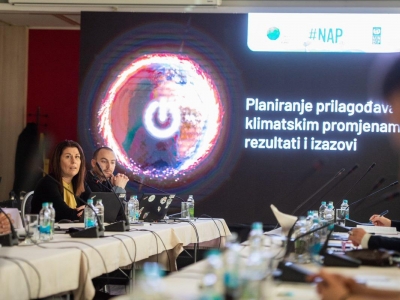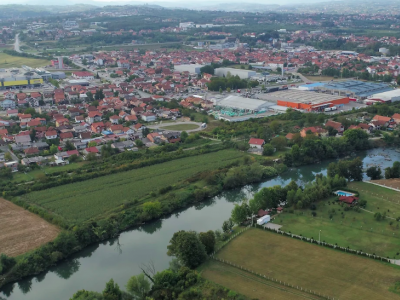Readiness for the National Adaptation Plan Process in Bosnia and Herzegovina
Project Overview
The project “Advance the National Adaptation Plan (NAP) process for medium-term investment planning in climate sensitive sectors in Bosnia and Herzegovina (B&H)” supported the Government of Bosnia and Herzegovina to advance the National Adaptation Plan (NAP) process and reach goals outlined in the Paris Agreement and 2030 Agenda for Sustainable Development. The project activities enabled the government to integrate climate change-related risks, coping strategies and opportunities into ongoing development planning and budgeting processes.
Bosnia and Herzegovina’s National Adaptation Plan (NAP) builds on the country’s Climate Change Adaptation and Low Emission Development Strategy of 2013. The strategy is based on four specific outcomes: supporting evidence-based policy development for climate change risks, vulnerabilities and opportunities; creating effective institutional and regulatory frameworks; mainstreaming climate change adaptation approaches into decision making; and effectively assigning resources and reaching implementation goals. The implementation of the strategy has slowed mainly due to lack of knowledge and institutional capacity to undertake adaptation measures.
To overcome these challenges, the project advanced adaptation planning in B&H with a focus on sectoral approaches, upgrading the knowledge base for adaptation, prioritizing adaptation interventions for the medium term, building institutional capacities for integrating climate change adaptation, and demonstrating innovative ways of financing adaptation at sub-national and local government levels. The project activities resulted in the compilation of a NAP and an implementation strategy focused on scaling-up adaptation in key sectors for the medium-term. Through the project, the Government of Bosnia-Herzegovina developed municipal-level investment financing instruments with public and private sector engagement, and built national, sub-national and sectoral capacity to integrate and mainstream risk informed planning and budgeting.
Project Details
Extreme climate events in Bosnia and Herzegovina are becoming more frequent; with seven out of the past 16 years experiencing drought and frequent floods. Annual temperature increases and change of precipitation are resulting in extreme weather conditions: heat waves, waves of extreme cold, and windstorms. The economic damages are vast, especially in the water, agricultural and housing sectors. The total economic impact of the 2014 floods is estimated to have reached EUR 2.04 billion, or 15 percent of the country’s GDP in 2014.
The NAP process in Bosnia and Herzegovina was officially launched in 2016 with a national consultation that engaged sector ministries and local government units via associations of cities and municipalities in Republika Srpska and Federation of B&H. B&H has put great emphasis on climate change as one of the most significant development challenges facing the country. The importance of adaptation was clearly reflected in its National Communications to the UNFCCC and Climate Change Adaptation and Low Emission Development Strategy (CCA LEDs), adopted in 2013. This strategy is based on four specific outcomes covering climate change risks, vulnerabilities and opportunities supporting evidence-based policy development, effective institutional and regulatory framework, mainstreaming CCA approaches into decision making, and effective resourcing with timely and effective implementation. However, its implementation has slowed mainly due to lack of knowledge and institutional capacity to attract finances and undertake adaptation measures.
The main identified barriers are:
- Limited institutional capacities and weak vertical and horizontal coordination for adaptation planning and implementation caused by complex administrative structure and top-down approach, limited stakeholders’ participation in B&H strategic planning for adaptation, inadequate level of technical knowledge on climate change adaptation of staff in sectoral ministries, limited training on climate change issues and low capacity to monitor, forecast, archive, analyse, communicate, and use climate risks and impacts for sectors.
- Limited climate Information to support integration of climate change into planning and budgeting due to limited scientific data and information on climate impacts and vulnerability assessments, limited knowledge of current climate variability, and a lack of systematic information on environmental protection.
- Alternative sources of finance, including innovative funds are not optimized as neither climate change adaptation, nor disaster-risk reduction (DRR) activities are included in budgeting on any level (municipal, cantonal, entity), and effective finance plan for securing adequate funds from a range of sources for adaptation does not exist.
The key results of the project include:
- An institutional framework to coordinate adaptation processes was established. The framework is based on four levels (NDA, nominated institutional coordinators, nominated interagency working group, and formed multi-disciplinary NAP drafting team).
- The first BiH NAP document was drafted identifying most vulnerable sectors and necessary adaptation actions in agriculture, water management, biodiversity, forestry, human health and tourism, with planned actions estimated over US$4.2 billion. Information on climate change impact and scenarios have been upgraded and vulnerability assessments have been completed for the most vulnerable sectors agriculture and water. The NAP document is currently under adoption at the state level.
- The Standard Operating Procedures (SOPs) for horizontal and vertical institutional cooperation on climate data exchange as well as the corresponding M&E framework have been adopted as part of the NAP document. The SOPs will enable cross-sectoral climate data/information exchange to support an effective monitoring and evaluation (M&E) framework, track implementation and assess the effectiveness of adaptation actions taken to enable regular updates of the NAP.
- The Project supported adjustments to the regulatory framework necessary for successful implementation of climate change adaptation activities in the country and for meeting B&H’s obligations to the EU and the UNFCCC. This included amendments to the Law on Environment and development of strategic documents related to flood risk management to achieve alignment with the EU Approximation.
- The NAP Communication Strategy has been developed and implemented leading to the development of numerous communication products to increase knowledge and awareness on adaptation processes including a presentation at the COP 26. Project stakeholders are particularly proud of the Photo Essay on adaptation activities and potential for actions in B&H cities, which was also shared by the GCF.
- Studies on the socio-economic impacts of climate change on hydro-energy potential for two river basins (Trebisnjica and Vrbas) were undertaken, as well as a Study on socio-economic impacts of climate change on agriculture in one of most productive agricultural areas within the Sava Basin. These studies constitute the basis for informing planning and implementation of adaptation actions in water management and agriculture sectors.
- Studies assessing risks of urban torrential waters were conducted in two pilot cities (Tuzla and Banja Luka) and adaptation options were developed to improve adaptation planning in local communities.
- Trainings were conducted to build capacity of over 900 government staff for assessment, prioritization, and implementation of climate change adaptation actions as well as for development of reporting, monitoring and review mechanisms.
- Climate change data management system has been designed for the first time in B&H to enable climate data collection, exchange and assessment. The Platform is based on agreed SOP and the corresponding M&E framework will enable regular update of the NAP and other climate reports, tracking of climate data trends, implemented adaptation actions and its effects.
- Finance mechanisms, tools, and new financing approaches for adaptation finance are developed in four municipalities (Laktasi, Zenica, Sanski Most and Trebinje) to enhance adaptation investments at the local level. All four municipalities have developed and adopted their local Climate adaptation finance strategies and investment plans, developed project concepts, and were trained on adaptation finance mechanisms, benefiting over 320 participants from the four pilot municipalities.
- The Project developed two GCF Project Concept Notes (for water and agriculture sectors as the most vulnerable to climate change) and prepared the first Climate Adaptation Finance Strategy at the country level.
News
Exposure story: A race against nature (2019)
Exposure story: Giving trees (2019)
Exposure story: Fixing farming (2019)
Exposure story: Managing risk (2019)
Choosing peaches over apples (2021)
True Value (2021)
The Peak of Resilience (2021)
Climate change academy trainings held (2021)
Changing what we eat to help the planet (2021)
Exposure story: Financing for survival (2022)
Exposure story: Cities at the crossroads (2022)
NAP Bulletin PDF (2022)
NAP Bulletin PDF (2021)
U Tesliću održan okrugli sto na temu prilagođavanja klimatskim promjenama u Bosni i Hercegovini (2022)
Key Results and Outputs
Outcome 1: Effective national adaptation coordination system established to drive the NAP process
Outcome 2: Capacity for climate vulnerability assessments, development of socio-economic scenarios strengthened, and adaptation options prioritized for two key sectors
Outcome 3: Innovative financing strategy for adaptation investments developed and tested in four to five selected municipalities
 Bosnia and Herzegovina finalize country's first climate change National Adaptation Plan
Bosnia and Herzegovina finalize country's first climate change National Adaptation Plan  Strong Governance, Reduced Risks
Strong Governance, Reduced Risks  Why planning for adaptation is important to Europe and Central Asia
Why planning for adaptation is important to Europe and Central Asia